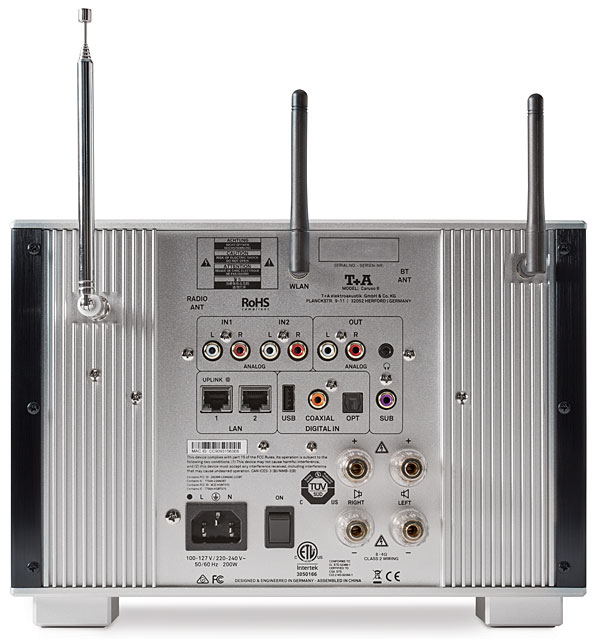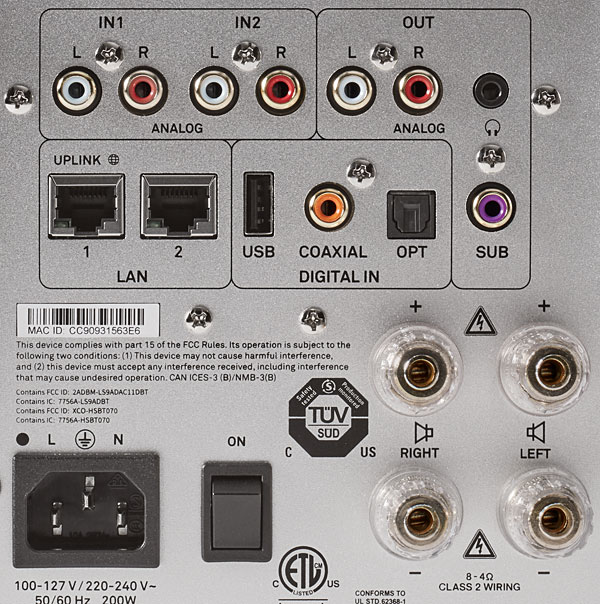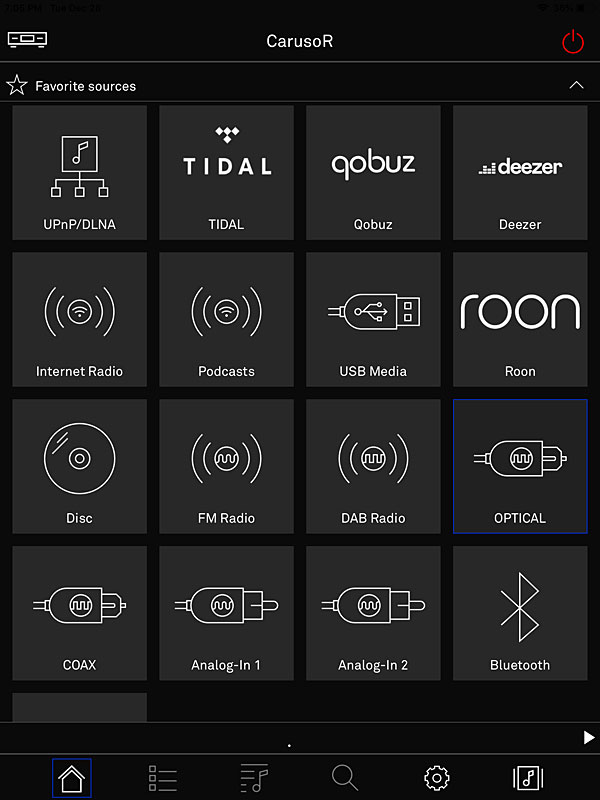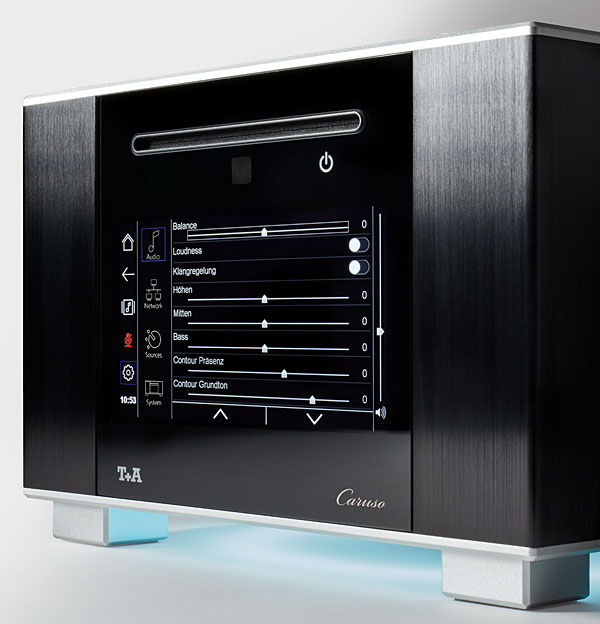| Columns Retired Columns & Blogs |
I think we can all agree that some T+A is good from time to time. I'll see myself out.

This experience marked the first time I'd listened to spoken-word media on a hi-fi system. That system was T+A's Caruso R multisource receiver ($4100) coupled with the same company's S 10 floorstanding loudspeakers ($3500/pair). Audible was sending the narration to the Caruso from my iPhone via AirPlay. AirPlay may not be hi-rez, but it was convenient, worked well, and was more than adequate for the use I was putting it to.
The Caruso R is part of T+A's Caruso line of compact, multi-function products. The R is a full-featured, two-channel, multi-source receiver/player with DSP. Plus, it's a networked integrated amplifier with a CD transport and a streaming DAC. It has Apple AirPlay 2 and Qualcomm aptX Bluetooth (A2DP 1.2 for audio), which works in both directions—you can send music to it or from it—and it receives old-fashioned FM radio (telescopic antenna included) plus internet radio via Airable. (For any Europeans and other outlanders reading this, there's also DAB+.)
The R supports the usual streaming services: Qobuz, Tidal, Deezer, Spotify Connect (third-party), and Amazon Music, the last with Alexa support. It has been tested by Roon, is fully interoperable with Roon, and is automatically identified by Roon as an endpoint. But because it interacts with Roon via AirPlay, it does not qualify for either of Roon's current formal certifications, Roon Ready and Roon Tested. The AirPlay-based connection means that Roon will downsample hi-rez data sent to the R over the network to 16/44.1. There is a Roon button in the Android/iOS apps, which starts up the Roon app if it's installed, although at the time I tried it, it had been disabled by a recent Roon update. T+A says it will be working again soon, probably by the time you read this. In the meantime, the Caruso R remains a fully functional Roon endpoint, accessible from the Roon app.

Inputs include LAN (one in, one out), wireless network (WLAN), USB 2.0, S/PDIF over RCA, TosLink, and a pair of analog inputs over RCA, which are digitized. There's one volume-controlled analog preamp output pair (RCA) and a subwoofer output (also RCA). There's a 3.5mm headphone output on the back panel with all the other connections.
Befitting a lifestyle product, the Caruso has an alarm clock, a sleep timer, and a dimmable ambient light glowing from beneath the chassis in user-selectable colors and/or combinations. The Caruso R is all-PCM; DSD isn't supported. That didn't impact my listening, but it could impact yours.
The Caruso R is in its third iteration. Caruso is made in China—it's the only T+A line not made in Germany—and the price reflects it. T+A designs all its own drivers and parts in-house and works with long-term partner manufacturers in China.
The R arrived chez moi with a pair of Caruso S 10 midsize ported three-way speakers, which I'll mention some, but this review will focus on the R.

Outside and in
The Caruso R is an attractive compact box. The look is classic, not trendy. Maybe it's because I'm finishing this review the week before Christmas, but its squareness, dimensions, and glowing LED make me think of a Christmas present in a shiny box.
Jim Shannon, the head of export sales at T+A and my contact, obtained responses to my technical questions from T+A's 13 in-house engineers. Each specializes in a certain area, so Shannon directed each question to the person most qualified to answer it.
The Caruso R chassis contains four boards, each mechanically and electronically isolated. For rigidity, there's a "massive aluminum framework; a complex, profiled extrusion acts as the load-bearing support for the entire internal architecture," I learned in an email relayed by Jim Shannon. The R is a little beast, although it isn't that heavy.
Amplification is class-D, and the same circuitry handles the conversion of digital signals. "Unlike most digital products, the Caruso was designed with a fully integrated digital conversion and analog output/amplifier stage," I learned in an email. "We do not use any separate DACs, since we have developed a complete digital direct signal path including our own class-D power amp stage, consisting of a [Texas Instruments] TAS5558 HD-compatible audio processor and [two] TAS5243 processors."
Setup and use
You can control the Caruso R via its large (7") touchscreen or via the CarusoNavigator app for iOS and Android (footnote 1). The unit also ships with a small remote control, which is useful for basic functions. During a brief pre-omicron visit, Shannon configured the system on his iPad to show me how the app works. At the start of this review period, though, my iPad and iPhone were both old, and my iPhone's Wi-Fi was broken, so until my new iPhone arrived, I used the Caruso R's capacious touchscreen for setup and control.
The touchscreen worked fine apart from a few quirks. On some pages, navigation up and down is controlled by a slim vertical scrollbar on the screen's right side, so narrow that using a fingertip is difficult. "Deeper" pages use up and down arrows in place of the scrollbar, which works better. The mode of operation, though, was clear and intuitive, and it was easy enough to drill down into menus. Apart from album cover art, which is displayed during playback, the graphics are pretty basic.
I set up Tidal and Qobuz on the touchscreen, entering my account information in a familiar (if clunky) way. I don't use Deezer or Spotify, but both are options. You can mark certain sources—certain inputs—as favorites; you start with a longer list and deselect the ones you don't want.
Once I had my new iPhone, I downloaded the Caruso mobile app, and that became my main system navigator. The app facilitates search and displays album artwork alongside search results and track listings. I found the app smoother and easier to use than the touchscreen. Still, both methods allowed me to access particular tracks with just a few touches.

The app, too, had occasional glitches and quirks. If you look you can find bit depth and sample rate, but the information is unreliable and doesn't seem to change. In Tidal, where the highest-resolution (non-MQA) content is 16/44.1, the Caruso displays "FLAC 1411kb/s"; 44.1 implies a bit rate of 705.6kb/s, multiplied by two (for two channels) to get to that rate. In Qobuz, the display reads "FLAC 24-bit>96kHz," regardless of what's playing. When I inquired about this, T+A told me that restrictions imposed by a third-party API, which allows the app and the Caruso to talk to each other, currently prevent transmission of detailed stream information. They also said that T+A is working with that company on an extension of the interface. Other occasional glitches with the app: A track repeated when I had not set it to repeat; an advance-track command was temporarily unresponsive. Putting the Caruso in standby and then back on again, which takes just a few seconds, always resolved such glitches. By the time you read this, these and other glitches could already be fixed. Users can report issues to T+A from within the app.
Some casual listeners will want to use Amazon's Alexa voice command to control the Caruso R. I logged into my Amazon account and tried it briefly, asking Alexa to "Play music by Kim Gordon," "Mute volume," and "Unmute volume." Alexa complied with these commands but refused to go along with "Alexa, stop internet radio" and "Hey Alexa, stop the music." One problem with Alexa is that if you ask her to play music, she'll always use Amazon. Alexa won't find tracks on Qobuz, Tidal, or the other streaming services. I preferred other control methods.
It was time to listen to some music.

Listening
After all this discussion about the Caruso R's functions, you may be wondering how it sounds. Paired with the S 10 three-way, bass-reflex, floorstanding loudspeakers, control and coherence were strong suits. Some of the Caruso system's sonic characteristics—its orientation toward clean, pristine sound—reminded me a little of the Naim Mu-so 2nd Gen (although in the Muso, the speakers are internal and so inevitably more limited on the low end). This precision was coupled with musicality and a degree of that freed-up feeling I love, of the speakers releasing the music completely, a trick my reference MBL 120s perform very well. There was a sense of smooth seamlessness without harsh edges, particularly in the highs. Since this is not a review of the speakers, that's the last I'll say about the S 10s.
